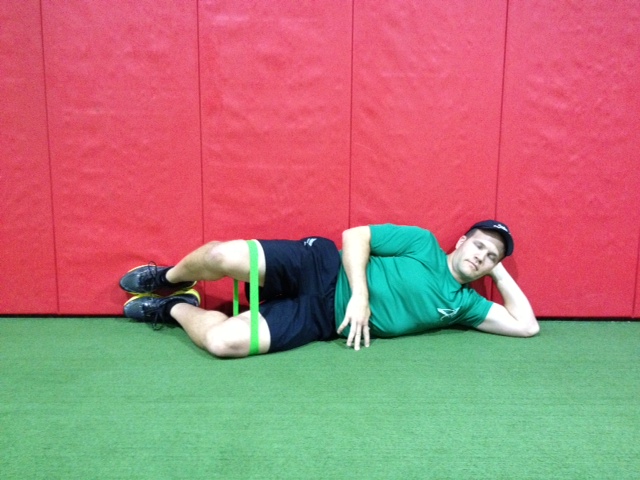
Weakness in the gluteus maximus and gluteus medius is often cited in contributing to patellofemoral pain, IT band problems, hip pathology and even back pain. Furthermore, activating the glutes and minimizing tensor fascia lata (TFL) activation is preferential to avoid synergistic dominance with abduction exercises.
In the 2013 issue of the Journal of Orthopaedic and Sports Physical Therapy (JOSPT), Selkowitz et al. examined several exercises to determine which ones had the highest gluteal-to-TFL muscle activation index. The clam exercise proved to be the best with an index value of 115. The second highest exercise was a sidestep with elastic resistance with a value of 64. I will cover this exercise in the next column.
Execution:
Begin in a side lying position with both limbs flexed to 45 degree at the hip and 90 degree at the knee. The back and bottom of the feet are placed against a wall for control of position and movement. Raise the top knee so that the hip is in 30 degrees of abduction, before returning to the starting position while keeping both heels in contact with each other and the wall.
Often, I will place a small towel roll between the feet to ensure consistent contact between the heels although this was not the technique used in the study. Perform 2 sets of 10-15 repetitions. Be sure that there is no slack in the resistance band at the start position.
In the 2013 issue of the Journal of Orthopaedic and Sports Physical Therapy (JOSPT), Selkowitz et al. examined several exercises to determine which ones had the highest gluteal-to-TFL muscle activation index. The clam exercise proved to be the best with an index value of 115. The second highest exercise was a sidestep with elastic resistance with a value of 64. I will cover this exercise in the next column.
Execution:
Begin in a side lying position with both limbs flexed to 45 degree at the hip and 90 degree at the knee. The back and bottom of the feet are placed against a wall for control of position and movement. Raise the top knee so that the hip is in 30 degrees of abduction, before returning to the starting position while keeping both heels in contact with each other and the wall.
Often, I will place a small towel roll between the feet to ensure consistent contact between the heels although this was not the technique used in the study. Perform 2 sets of 10-15 repetitions. Be sure that there is no slack in the resistance band at the start position.
 |
|
Application:
Engaging the gluteals and increasing abduction strength while minimizing TFL activation will help improve alignment and reduce femoral IR on the patella. Current thought is that this may be the most effective way to reduce anterior knee pain. In addition, improving gluteal activation will reduce load on the back, hip and knee. Incorporating this exercise in side lying is a simple way to strengthen for clients of all ages and abilities.
Additional notes:
Additional research done by Wilcox and Burden (published in the May issue of JOSPT) suggests that a neutral spine alignment and 60 degrees of hip flexion is the best position for gluteal activation. This study was done without resistance but offers additional insight to positioning. I try to mimic this hip flexion angle in the standing single and double leg versions I employ with mini-bands as part of my gluteal activation series in the clinic as well.
Brian Schiff, PT, OCS, CSCS, is a licensed physical therapist, respected author and fitness professional. Currently, he serves as the supervisor at the Athletic Performance Center in Raleigh, NC. Brian presents nationally at several professional conferences and seminars on injury prevention, rehab and sport-specific training. For more cutting edge training information, subscribe to his monthly Training & Sports Medicine Update at www.BrianSchiff.com.

















